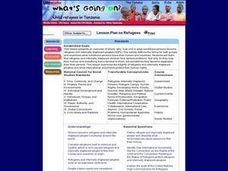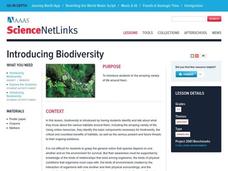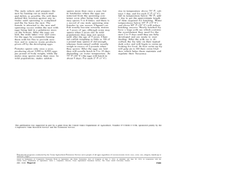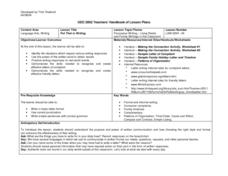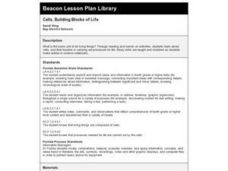Curated OER
Prairies
Students identify the basic characteristics of the prairie ecosystem, and several commonly known prairie species. They create a classroom mural of a prairie ecosystem; and create reports about what they have found out.
Curated OER
Major Functions
Seventh graders investigate the basic characteristics and needs of living things. They identify the major parts of plants and animals by making lists. Students focus upon one living thing and speculate how if one part is changed how it...
Curated OER
An Introduction To NGO's Gender Equality Program
Eleventh graders are introduced to the hardships women are facing to the projects of a variety of organizations. They assess Canada's participation in world affairs with reference to human rights and modern conflicts. Pupils compare...
Curated OER
Louisiana Cinquains
Students enhance their understanding of parts of speech by writing a cinquain poem about Louisiana. In this cinquain poem lesson, students read example cinquain poems and study the format for a cinquain poem. Students create a class poem...
Curated OER
Lesson Plan on Refugees
Pupils explore the issue of "human rights" and discuss world events/situations in which human rights are in question. They determine their own needs and wants and simulate the experience of being a refugee having to leave their home. ...
Curated OER
Who's for Dinner?
Fifth graders examine life systems within different biomes. They choose paper plates with the names of animals on them. They research the animals, write reports and draw pictures of them. They create a food chain model by arranging the...
Curated OER
A Tale of Two Reactors
Tenth graders role-play as members of the food chain. Sticky tables acting as polluting factors are introduced and members of different trophic levels suffer varying degrees of damage due to those pollutants.
Curated OER
We Need Cash
Students describe charitable, religious, and civic services in their community, and argue for the value of these services. They write a one-page explanation as to why this service is important to the community and why it deserves $5,000.
Curated OER
What Can We Learn from Artifacts?
Students examine how artifacts are discovered and explore their significance as it pertains to gathering important information. In this artifacts lesson, students obtain knowledge about the way artifacts are excavated and examine an...
Curated OER
Introducing Biodiversity
Students are introduced to the life around them. As a class, they discuss their prior knowledge about the habitats in their local area. Using the internet, they identify the basic components needed for biodiversity and the major...
Curated OER
Pond 2: Life in a Drop of Pond Water
Students observe organisms found in pond water with a microscope. In groups, they discuss how single-celled organisms satisfy their needs for food, water and air. They compare and contrast the needs of macroscopic and microscopic...
Curated OER
Ecology and The Endangered Species Act
High schoolers listen to a lecture about the basics of Ecology. They take a field trip in which they observe a specific organism and their characteristics.
Curated OER
The Human Body
Students make life-size models of their bodies by having a partner trace them. They glue the basic body parts in the proper places and decorate them with hair, and facial features.
Alabama Learning Exchange
Mitosis: Divide to Survive
Learners identify the purpose of cellular mitosis. They work in groups of four to use images of animal and plant cell mitosis to illustrate each step in the mitosis process on their graphic organizer.
Curated OER
Mining the Web
Students complete searches using a directory, search engine, and meta-search engine. In this Internet research lesson, students complete Internet searches using a directory, basic search techniques, advanced search techniques, and a meta...
Curated OER
Channel Catfish
Students study the life and biology of the Channel Catfish. In this aquatic biology lesson, students will examine the external and internal features of the catfish along with their breeding habits and environment. This lesson includes...
Alabama Learning Exchange
The Tree of Life
Young scientists use the Internet to evaluate how organisms are classified. They research the phylogeny of organisms and how they are linked in a certain way. Pupils hone research technology skills with their final presentations.
Curated OER
Metals, Non-Metals, Metalloids
Learners describe properties of various elements. They arrange the elements based on properties in order to explain the organization of the periodic table. They label elements as metal, non-metal, or metalloid.
Curated OER
Put That in Writing
High schoolers identify life situations which require various writing responses, use the power of the written word to obtain results, practice writing responses to real-world events, and demonstrate the skills needed to recognize and...
Curated OER
Investigating the Structure of the Flower
Learners investigate the structure of the flower. In this biology lesson plan, students examine the basic anatomy of a flower by means of creating a model and understand the proportional relationships of the various parts illustrated.
Curated OER
Plant Growth
Students role play as text book creators by designing an animation showing plant growth from seed to maturity. They incorporate things that plants need to grow in the animation.
Curated OER
Cells, Building Blocks of Life
Fourth graders, in groups, explore cells, the basic unit of all living things.
Curated OER
Learning the Dissecting Planes
Middle schoolers explore dissecting planes. For this biology lesson plan, students learn the basic vocabulary used in dissection, learn how to orient themselves on a three dimensional figure, and develop the manual dexterity necessary to...






